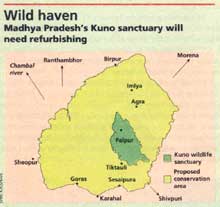Preparing the jungle for its king
 Intensive management of Kuno forests is required before lions can be introduced in the area, claim Wildlife Institute of India researchers. Because the population of herbivores such as chital, nilgai, sambar and blackbuck is too low to sustain the lions, it is planned to introduce over 5 years 500 of each of these species in the area.
Intensive management of Kuno forests is required before lions can be introduced in the area, claim Wildlife Institute of India researchers. Because the population of herbivores such as chital, nilgai, sambar and blackbuck is too low to sustain the lions, it is planned to introduce over 5 years 500 of each of these species in the area.
About 5-7 adult lions taken from a single pride would be translocated. The capture, transport by road or possible airlifting and release in Kuno is to be done in the cool season. The lions will be first released into a circular area of 60 metre radius surrounded by a strong lion-proof chain link fence. The cats will be kept fenced for about 10 days to help them acclimatise themselves to their new home.
All the lions, fitted with radio collars, will be monitored regularly after their release into the wild to assess the success of the programme through diet, reproductive performance and social organisation. Supplemental feeding of the lions through baits will be withdrawn 3-6 months after their release.
Subsequently, the translocated population will be supplemented by lions captured from Gir as a population management requirement. This will also add to the genetic diversity of the Kuno lions as fresh male lions are moved from Gir every 3-5 years and resident males in Kuno selectively captured for zoos. A free ranging population of 30-50 lions is expected to be built up in Kuna in the first 10 years.
With 8 tigers reported in Kuno in the last census in 1993, conflicts between the big cats is anticipated. However, foresters are hopeful that given the low density of tiger population in Kuno area and the lions' being drawn from the same pride, serious conflicts between them may not occur.
